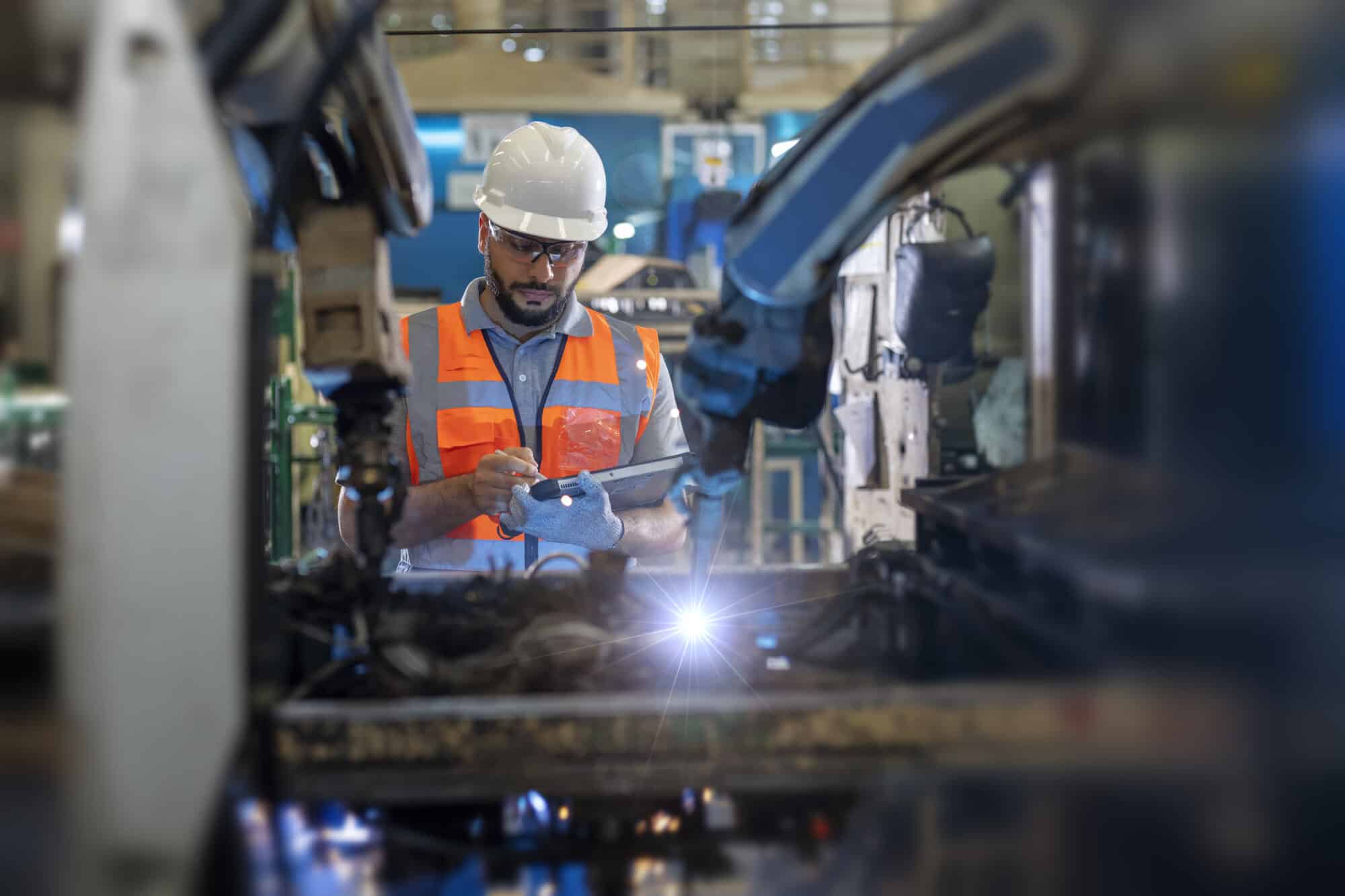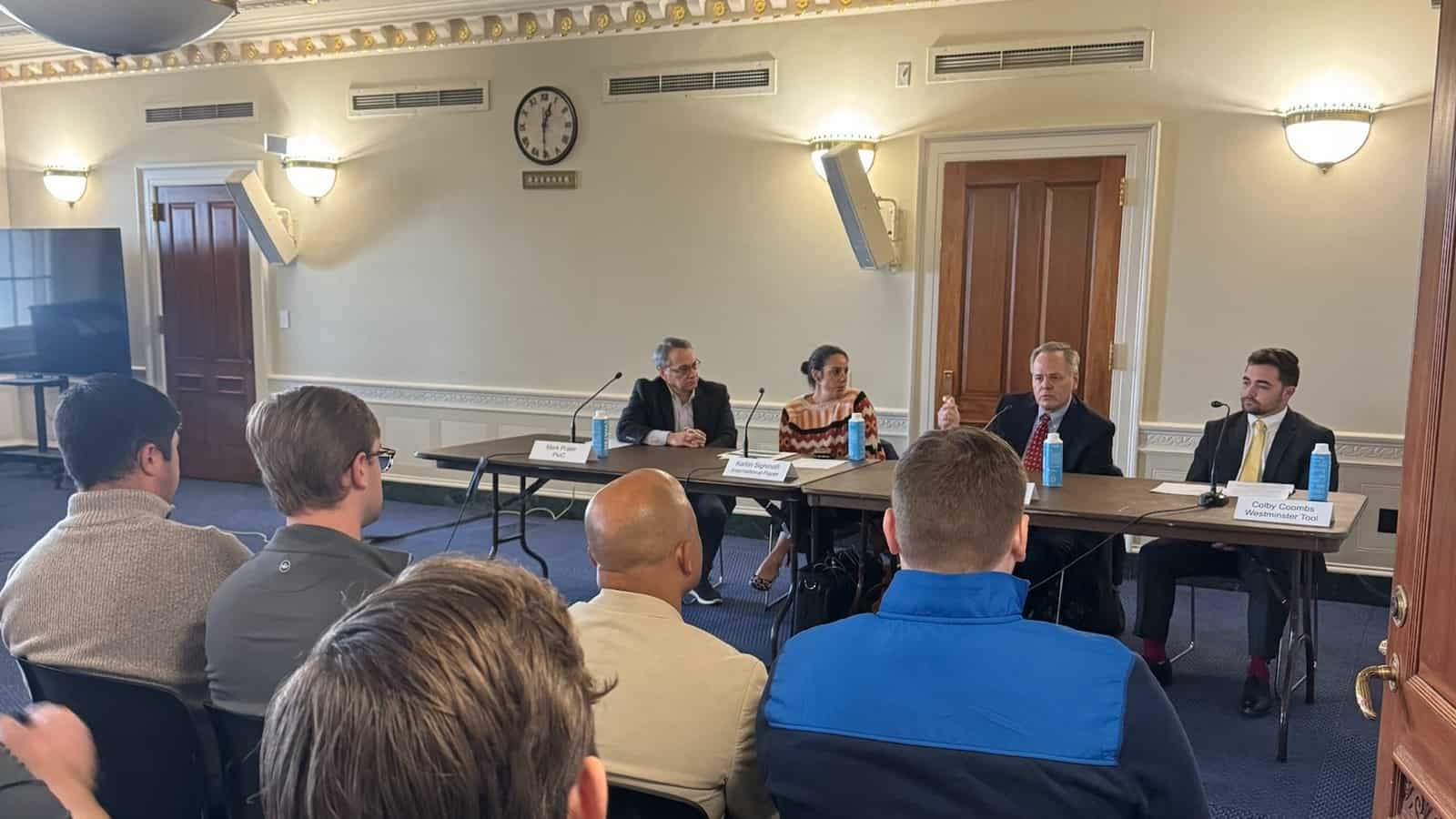Producer Prices Increase Less Than Expected

Prices paid by businesses to goods and services producers in the U.S. rose by slightly less than anticipated in March, according to Investing.com.
What’s going on: “The producer price index for final demand rose 0.2% last month, after rising by 0.6% in February, the Labor Department’s Bureau of Labor Statistics said. Economists had expected the PPI to gain 0.3%. In the 12 months through January, the PPI increased 2.1%, below the 2.2% expected, after climbing 1.6% in February.”
- “Core” PPI, which excludes food and energy prices, rose 0.2% on the month, for an annual increase of 2.4%.
- The data comes just a day after the release of a higher-than-anticipated consumer price index for last month.
The details: Services inflation stayed elevated, with a gain of 0.3% in prices in March, Barron’s reports.
- Goods prices, however, edged down 0.1%.
- A 1.6% decline in energy prices made up much of March’s overall decrease and outweighed a 0.8% increase in food prices.
Why it’s important: The news may mean an interest-rate cut from the Federal Reserve will come later than previously thought.
Consumer Prices Increased in March

Prices paid by consumers for goods and services rose last month, according to CNBC.
What’s going on: The consumer price index, “a broad measure of goods and services costs across the economy, rose 0.4% for the month, putting the 12-month inflation rate at 3.5%. Economists surveyed by Dow Jones had been looking for a 0.3% gain and a 3.4% year-over-year level.”
- March’s seasonally adjusted CPI increase was the same as February’s.
Core CPI: Core CPI, which excludes often volatile food and energy costs, also increased 0.4% on a monthly basis.
- Core CPI for March was 3.8% higher than it was in March 2023.
Why it’s important: CPI is the most widely used measure of inflation, and these data “indicat[e] that inflation is staying stubbornly higher and likely keeping the Federal Reserve on hold with interest rates.”
Previewing the State of the Union

With President Biden set to deliver the State of the Union address Thursday, manufacturing is likely to be in the spotlight once again. At the NAM, we will be listening closely for our key priorities—those that have been achieved and those still in progress.
Promises kept: President Biden has been a partner on a range of issues that are key to manufacturers across the United States. We hope he will outline how pro-growth legislation has helped set the stage for manufacturing growth, with industry employment reaching a 15-year high.
- CHIPS Act: The CHIPS and Science Act marked a major push to boost manufacturers’ competitiveness, supporting large and small businesses up and down the supply chain by investing in domestic semiconductor production and funding programs to support the STEM workforce, advanced technology development, excavation of critical minerals, clean energy and more.
- Bipartisan Infrastructure Bill: President Biden secured a bipartisan $1.2 trillion infrastructure bill, a long-sought, major achievement for manufacturers throughout the country, offering transformational upgrades and significant investments in America’s manufacturing capabilities.
- Inflation Reduction Act: Some of the provisions in the Inflation Reduction Act supported manufacturers across the United States, with direct investments and tax credits generating a major increase in manufacturing construction and jobs.
- Ukraine: The Biden administration has been unwavering in its support of Ukraine. The NAM—which in March 2022 passed a unanimous resolution denouncing Russia’s invasion of the country—has kept the pressure on Congress to pass the stalled Ukraine aid bill.
Progress to come: But this progress will be undermined if the Biden administration continues to issue onerous regulations and call for policies that make it harder to innovate, invest and expand in America. The NAM is working hard to push back against items that would harm manufacturers and encourage the president to refrain from pursuing policies that will make us less competitive.
- Taxes: The NAM is pushing back against any new taxes or attempts to increase tax rates on manufacturers, and we are pressing for tax policies that will make it easier to invest in the future—including the “tax trifecta” found in the recently House-passed Tax Relief for American Families and Workers Act. The NAM urges the Senate to approve these business tax provisions quickly.
- Protecting intellectual property: Late last year the administration proposed invoking “march-in” rights to seize the patents of any products it deems too costly—if those innovations were developed in any part with federal dollars. This move, which would open the door to similar actions in other sectors of manufacturing, would undermine manufacturers’ IP rights, disincentivize early-stage entrepreneurship and dissuade capital investment, all of which could jeopardize our ability to develop future cures. This is just one example of how actions that undermine manufacturers’ IP can have dangerous unintended consequences.
- Regulations: Burdensome rules—such as the tighter National Ambient Air Quality Standards from the Environmental Protection Agency and the Department of Energy’s recent freeze of liquefied natural gas export permits—are preventing manufacturers from creating jobs and harming U.S. competitiveness. We need to end the regulatory onslaught and give manufacturers the chance to grow.
- Energy: Manufacturers in America are at the forefront of the planet’s work to reduce emissions and promote sustainable energy. But to be effective, we need to embrace an all-of-the-above energy strategy that uses the fuel we have while developing the tools we need.
- Immigration: Immigration and border security reforms must be a priority for the administration and Congress. Inaction poses significant economic risks—especially at a time when manufacturers have 600,000 open jobs. Manufacturers are leading on bipartisan solutions, like those found in our A Way Forward plan.
The last word: “Our commitment is to work with anyone, and I truly mean anyone, who will put policy—policy that supports people—ahead of politics, personality or process,” said NAM President and CEO Jay Timmons. “Because here’s what I know: Manufacturers are building an incredible future for our country and our world. And we need partners in the federal government who will work with us to reduce burdens on manufacturers and manufacturing workers, rather than creating barriers to our success.”
Learn more: For more information on the state of manufacturing, check out the 2024 NAM State of Manufacturing Address here.
Manufacturer Optimism Still Low

The higher tax burden being levied on manufacturers continues to hit home.
That’s the message from respondents to the NAM’s just-released Q4 2023 Manufacturers’ Outlook Survey.
What’s going on: Historically low levels of optimism persisted among small and medium-sized manufacturers—which compose the majority of the manufacturing sector—in the final quarter of 2023, according to the survey, which was conducted from Nov. 14 to Dec. 1, 2023.
- Among firms with fewer than 50 employees, 65.9% reported feeling positive about their own company’s outlook, while 63.0% of companies with between 50 and 499 employees reported the same.
- Overall, 66.2% of respondents felt either somewhat or very positive about their company’s outlook, edging up slightly from 65.1% in the third quarter. It was the fifth straight reading below the historical average of 74.8%.
Burdensome taxes: Some 89% of respondents said higher taxes on manufacturing activities would make it more difficult for them to hire additional workers, invest in new equipment and/or expand their facilities.
Other top challenges: The majority of respondents—61.1%—cited an unfavorable business climate as a top challenge to their company.
- Hiring and retaining quality employees was high on the list of challenges, too, with 71.4% of manufacturers calling it a primary concern.
A bright spot: Fewer manufacturers now expect a recession in 2024, at just over 34%. In Q3, the figure was 42.2%.
Manufacturers to Congress: Restore Pro-Growth Tax Policies Now

In the third quarter of 2023, private-sector R&D spending fell by 1.2%, according to the Bureau of Economic Analysis. Since a harmful R&D amortization requirement took effect in 2022, R&D spending’s rate of growth has slowed dramatically, from 6.6% on average over the previous five years to less than 1% over the past 12 months.
- To protect well-paying R&D jobs and America’s competitiveness, Congress must restore immediate R&D expensing, manufacturers told Congress this week.
What’s going on: At a Monday briefing for staffers of the Main Street Caucus—a group of more than 70 Republican House members that advocates for small businesses—Westminster Tool Chief Financial Officer Colby Coombs talked about the harmful impact the R&D tax change has had on his injection-mold-making business.
- “We’re paying more than double what we made in cash profit last year to the IRS for federal income tax,” he said.
- “To put it differently, we paid just under an additional $27,000 per full-time employee in [our] tax bill this year. It is impossible to continue running your organization paying this amount in taxes [and] not being able to expense our research and development expenditures immediately.”
The background: For close to seven decades, the U.S. tax code allowed businesses to immediately deduct R&D expenses. But starting in 2022, it began requiring companies to amortize, or deduct, these costs over a period of years.
- Also in 2022, a stricter interest limitation—essentially a tax on investment—went into effect. According to a new analysis recently released by the NAM, the stricter limitation could cost nearly 900,000 jobs.
- Earlier this year, full expensing, which allows businesses to deduct the full cost of capital equipment purchases, began to phase down. It is set to fully phase out by 2027.
The effects: According to the Q2 2023 NAM Manufacturers’ Outlook Survey, 78% of manufacturers say the higher tax burden has decreased the funds available to expand core manufacturing activities in the U.S.
- The tax changes “forced us to cancel a major aviation contract this year that would’ve added five new jobs in our community,” Coombs continued. “Five jobs might not seem a lot, but that’s almost 17% of our workforce growth.”
- “We do what we love, which is make good products and make improvements for our country, [but] this is greatly handicapping our ability to continue to grow.”
NAM in action: The NAM has mounted an all-out campaign calling on lawmakers to reinstate immediate R&D expensing, pro-growth interest deductibility and full expensing (or 100% accelerated depreciation).
- Earlier this month, the NAM led more than 1,300 businesses and associations in calling for the measures’ reinstatement.
- It also launched the Restoring Pro-Growth Tax Policies Action Center, which provides background information on these priorities, as well as a digital engagement tool that helps manufacturers and industry advocates contact their senators and representatives.
The last word: Manufacturers are “absolutely vital … to continu[ing] to create good products that are safe and environmentally innovative to help our country,” Coombs said.
- “We need to be able to fully expense immediately, and we need to retroactively fix this [situation] so we can put our money into growing our workforce, purchasing new machines and improving our capabilities so we can compete at a global level.”
Retailers Whittle Down Holiday Offerings

This holiday season, instead of overstocking shelves with merchandise, retailers “have pared back their inventories while trying to focus their supply chains more tightly on products that shoppers want,” The Wall Street Journal (subscription) reports.
What’s going on: “Many retailers have spent much of the year working through the stockpiles from last year and now say they have cleaned up their distribution centers and their balance sheets.”
- After the global pandemic, sellers bulked up their stocks in case of another major supply chain disruption—but it was a “strategy that left many companies saddled with goods.”
A different holiday season: Owing to high inflation and more spending on services than goods, “[h]oliday retail sales in the U.S. are expected to grow at a slower rate this year.”
- “The National Retail Federation predicted sales will rise between 3% and 4% over 2022 to between $957.3 billion and $966.6 billion. Last year, holiday sales grew 5.3% to $936.3 billion.”
What they’re doing: Retailer strategies for this year include paying close attention to consumer trends and offering “variety [over] redundancy.”
- Said one retailer’s CEO, “The customer today does not want an endless aisle. They want the best aisle.”
Powell: Further Rate Hikes Possible

The still-robust U.S. economy and tight labor market could mean further interest rate hikes, Federal Reserve Chair Jerome Powell said Thursday, Reuters (subscription) reports.
What’s going on: “We are attentive to recent data showing the resilience of economic growth and demand for labor,” Powell said during a talk at the Economic Club in New York. “Additional evidence of persistently above-trend growth, or that tightness in the labor market is no longer easing, could put further progress on inflation at risk and could warrant further tightening of monetary policy.”
- The Fed’s aim in raising rates has been to reduce inflation to 2%.
- Since it began raising rates in March 2022, however, unemployment has stayed largely steady, and “economic growth has generally remained above the 1.8% annual growth rate Fed officials see as the economy’s underlying potential.”
A delicate balance: While Powell said there is evidence of a cooling labor market, the Fed must account for new “uncertainties and risks”—including the Hamas–Israel war—as it seeks “to balance the threat allowing inflation to rekindle against the threat of leaning on the economy more than is necessary.”
- Data since the central bank’s last meeting, in September, have shown unexpected U.S. job growth and surprisingly strong retail sales, “offering inconsistent signals about whether inflation is on track to return to the Fed’s 2% target in a timely manner.”
Hike likely: Most Reuters-polled economists expect the Fed to raise interest rates at its next meeting on Oct. 31–Nov. 1.
Existing Home Sales Fall

Sales of existing homes fell to their lowest level in 13 years in September, according to Reuters (subscription).
What’s going on: “Existing home sales fell 2.0% last month to a seasonally adjusted annual rate of 3.96 million units, the lowest level since October 2010, the National Association of Realtors said on Thursday. They are counted at the closing of a contract, and last month’s sales likely reflected contracts signed in August, when the rate on the popular 30-year fixed mortgage vaulted above 7%.”
- Sales fell 1.1% in the South, 4.1% in the Midwest and 5.3% in the West. They rose 4.2% in the Northeast.
Anemic inventory: There was 3.4 months’ worth of unsold existing home inventory for sale in September, a decline of more than 8% from a year ago.
- “A four-to-seven-month supply is viewed as a healthy balance between supply and demand.”
Why it’s happening: Mortgage rates have spiked recently, “mostly because of expectations that the Federal Reserve will keep interest rates higher for longer in response to the economy’s resilience.”
Housing Starts Rise

The number of new homes being built “showed a substantial rebound” in September, while the number of permits to build declined, according to Markets Insider.
What’s going on: “The Commerce Department said housing starts spiked by 7.0 percent to an annual rate of 1.358 million in September after plunging by 12.5 percent to a revised rate of 1.269 million in August.”
- At the same time, permits—an indicator of future demand for housing—dropped by 4.4% to an annual rate of 1.475 million, following a surge in August.
Less than predicted: Economists had predicted that September housing starts would spike to a rate of 1.380 million from the previous month.
Why it’s important: Mortgage rates have risen to record highs recently, pushed by the Federal Reserve’s still-elevated interest rate target.
- Higher rates have led to a decline in home sales and prices.
Economists: U.S. May Avoid Recession

Economists polled by The Wall Street Journal (subscription)—including NAM Chief Economist Chad Moutray—say they now believe that the U.S. will likely avoid a recession.
What’s going on: “In the latest quarterly survey by The Wall Street Journal, business and academic economists lowered the probability of a recession within the next year, from 54% on average in July to a more optimistic 48%. That is the first time they have put the probability below 50% since the middle of last year.”
- Economists on average expect gross domestic product to increase 2.2% in Q4 of this year from a year earlier, which is “a sharp upward revision” from the last survey.
Why it’s happening: Playing a role in the revised outlook are declining inflation, an interest rate that the Federal Reserve has held steady at its past two meetings, a robust job market and surprisingly strong recent economic growth.
A “soft landing”: While that growth and job creation are both expected to weaken in the first half of next year, “the latest forecasts suggest confidence in the Fed’s ability to achieve a so-called soft landing, in which inflation falls without a recession.”
- However, recent events—such as the Israel–Hamas war—could alter the accuracy of these predictions, given the potential effect on energy prices.
Our take: “Despite weaknesses in manufacturing demand and production and a multitude of challenges globally, consumers and businesses continue to spend, providing resilience to the U.S. economy,” Moutray told us.
- “Even with recent cooling, the labor market and wage growth remain solid, and firms continue to make investments in the domestic market. While real GDP is likely to slow in the next few quarters following a very strong Q3, the ‘soft landing’ scenario has become more probable in recent months.”